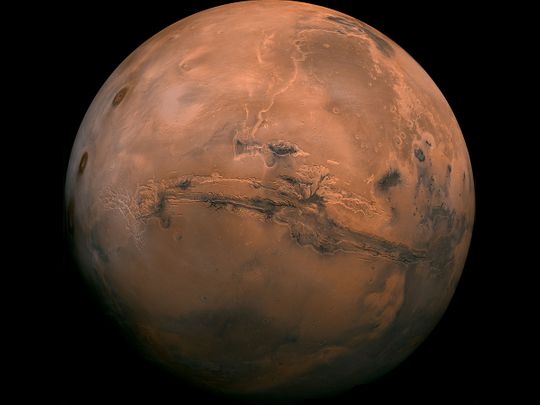
Everyone seems to have Mars on their mind, these days. US space agency National Aeronautics and Space Administration (Nasa) plans to send humans there by 2030, and American spacecraft manufacturer SpaceX wants to get there even sooner, by 2024.
Click start to play today’s space-themed Word Search.
Since Mars could very well be the next home for humans, here is a tour of the most interesting locations on the planet. Who knows? Future Martians could soon visit these destinations, and even claim it as their neighbourhood.
1. Olympus Mons

Considered to be the most extreme volcano in the solar system, Olympus Mons is about the same size as the entire state of Arizona, US, according to Nasa. At a height of 25km, it’s nearly three times taller than Earth’s Mount Everest. The gigantic shield volcano was formed after lava slowly seeped down its slopes – so it’s likely easy for future explorers to climb, since its average slope incline is just 5 per cent. While Olympus Mons is thought to be a relatively young volcano, it was last active some 25 million years ago, so don’t worry about explosions while you’re there!
2. Valles Marineris
Mars isn’t just home to the solar system’s largest volcano, but its largest canyon as well. Nasa estimates that Valles Marineris, which cuts across Mars’ equator, is about 3,000km long. Don’t be too enthusiastic about going on a trek in the Valles Marineris, though. In comparison, it’s almost 10 times longer, 20 times wider and five times deeper than the Grand Canyon in the US.
3. Medusae Fossae
One of the more bizarre locations on Mars, Medusae Fossae has been at the centre of several theories, with some people even speculating that it holds evidence of a UFO (unidentified flying object) crash. However, scientists think it’s more likely that the region is a huge volcanic deposit, where winds have sculpted rocks into incredibly beautiful formations.
4. Ghost Dunes

Wind plays a major role on Mars, since many of the planet’s features have been shaped by it. Regions with ‘ghost dunes’, found in Noctis Labyrinthus and Hellas basin, show both the effect of the wind and evidence of past water. Scientists think the regions were once home to dunes that were 10m tall, and were later washed away by lava or water, which preserved their bases while eroding the upper levels.
Would you live on Mars if you could? Play today’s Word Search and tell us at games@gulfnews.com.




